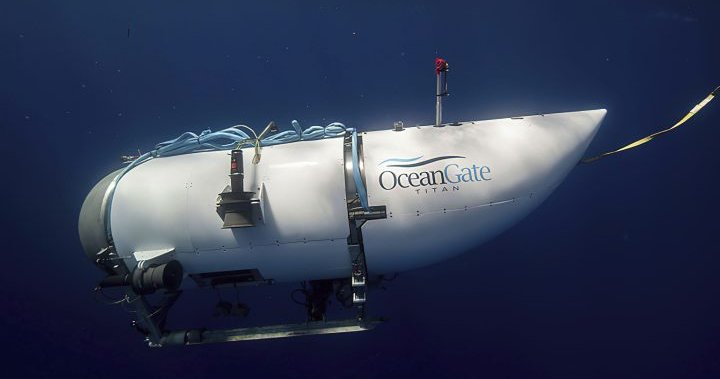OceanGate suspending operations weeks after Titan sub implosion – National | Globalnews.ca
OceanGate, the company behind the ill-fated Titan submersible that imploded during a descent to the Titanic last month, announced Thursday on its website it was suspending all exploration and commercial operations.
The announcement comes just over two weeks after the submersible went missing as it was set to take a tour of the Titanic wreckage deep in the Atlantic Ocean, off the coast of Newfoundland.
In a statement to Global News, OceanGate confirmed they would be suspending exploration and commercial operations, but said there was no additional information the company could provide other than the notice on its website.
On June 22, about four days after the craft went missing, the U.S. Coast Guard said a debris field had been found by searchers, with the company saying the five people on board “have sadly been lost.”
An international search effort had been underway since OceanGate Expeditions’ vessel and crew aboard went missing, with communication going dark shortly after dropping into the ocean.
Efforts to find the submersible had remained a “search and rescue” mission until June 22 with searchers having detected underwater noises on the two days prior. The noises offered potential hope those aboard the ship were still alive, but it was dashed within days.
Oxygen was estimated to run out sometime on the Thursday, and news that the vessel and crew were lost was made public later that day.
According to U.S. Coast Guard Rear-Adm. John Mauger, the debris field found near the Titanic wreckage was “consistent with a catastrophic implosion of the vessel.”

A remotely operated vehicle (ROV) discovered the debris field, according to the Coast Guard, with undersea expert Paul Hankin telling reporters five pieces of debris led them to conclude they had found the Titan’s remains.
The nose cone was found first, nearly 500 metres from the bow of the Titanic, followed by the “large” debris field where Hankin said the front end belt of the pressure hull was discovered — the “first indication” of a “catastrophic event.”
The other end of the pressure hull was found in a second debris field nearby.
The location of the debris field was consistent with the Titan’s approximate location when the surface vessel, the Polar Prince, lost communication, officials said.
The five passengers aboard the submersible were OceanGate CEO Stockton Rush, British billionaire adventurer Hamish Harding, French researcher Paul-Henri Nargeolet, Pakistani billionaire Shahzada Dawood and his 19-year-old son Suleman.
Shortly after, Canada’s Transportation Safety Board (TSB) said it was investigating the implosion and a Canadian-flagged ship’s role in the operation leading to the doomed descent.
Chair Kathy Fox said it was too early to say how long the investigation would take, as most can take between 18 months and two years. Its probe is specifically looking to identify what happened while the Titan was submerged, why the implosion occurred and what can be done to reduce the risk of it happening in the future.

The Royal Canadian Mounted Police (RCMP) also said it would examine the matter in order to determine if a full investigation is needed.
The U.S. Coast Guard has said medical professionals would be analyzing “presumed human remains” that had been recovered from the wreckage of the imploded submersible.
The statement was a shift from earlier comments suggesting the remains may never be found, in part due to the nature of the implosion and challenges facing the recovery team searching for debris.
In the days since, experts in emergency management have said the company behind the submersible, OceanGate, ignored key principles that guide organizations working in high-risk environments, which in turn could have meant the watercraft was doomed from the start.
Jack Rozdilsky at York University in Toronto told The Canadian Press that OceanGate’s business could be compared to the immensely risky work of companies launching space flights, drilling for oil offshore, fighting wildfires or operating nuclear power plants.
But unlike those “high-reliability organizations” (HRO) which operate in high-hazard domains for long periods of time “without serious accidents or catastrophic failures,” Rozdilsky said OceanGate appears not to have functioned as an HRO.
He added that HROs are reluctant to simplify and accept that the tasks they’re involved in are complex with the potential to fail in unexpected ways. They also are preoccupied with failure and don’t view near-misses as proof of success, and they practice resilience with backups for backups.
© 2023 Global News, a division of Corus Entertainment Inc.
For all the latest world News Click Here




